19 May 2008
I took this as something of an assignment. I crossed the River Karnaphuli many times through the two bridges across. But never had a real opportunity to photograph these important structures. I had an opportunity to visit Chittagong on an official trip. Though engaged for the afternoon, the morning hours were free for me. I didn’t wait a bit. I plunged into the plan and went about it.
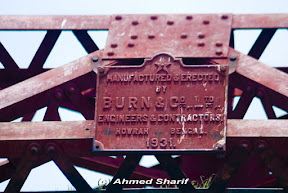 |
| From Bridges of Chittagong, Chittagong, Bangladesh |
The name is written in steel............
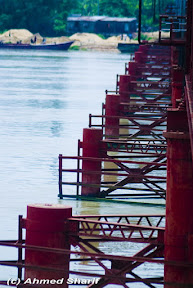 |
| From Bridges of Chittagong, Chittagong, Bangladesh |
This bridge is mostly made of steel.........
 |
| From Bridges of Chittagong, Chittagong, Bangladesh |
Some solid construction..........
 |
| From Bridges of Chittagong, Chittagong, Bangladesh |
Three wheelers crossing the bridge........
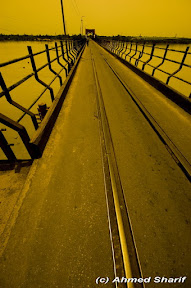 |
| From Bridges of Chittagong, Chittagong, Bangladesh |
The rail line through the middle of the bridge.........
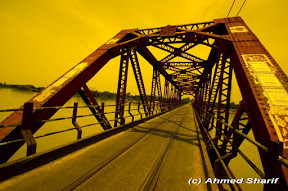 |
| From Bridges of Chittagong, Chittagong, Bangladesh |
The central steel piece of the bridge........
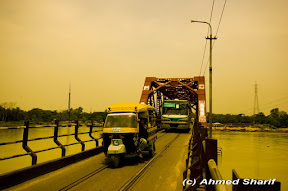 |
| From Bridges of Chittagong, Chittagong, Bangladesh |
This is a single lane bridge............
 |
| From Bridges of Chittagong, Chittagong, Bangladesh |
A bicycle crosses the bridge........
 |
| From Bridges of Chittagong, Chittagong, Bangladesh |
The metal structure..........
Kalurghat Bridge was the farther one; so, my plan was to visit that one first. I took a CNG taxi and reached there by around 11:15AM. It’s a pretty old bridge; over 70 years old. Around 2,500 vehicles and 5 trains cross the bridge every single day. This is a legacy left by the British. This was the only bridge across the River Karnaphuli during the Liberation War of 1971. So, there are a few old memories of many people with this bridge. Its part of the history too. The bridge was built in 1931. It was repaired many times. The last repair was done in 2005 at a cost of Taka 100 million. The bridge was closed for ten months at that time.
The bridge is a steel structure resting on steel pillars; only a few concrete pillars stand at each end of the bridge. This is one narrow bridge. Originally this was built as a railway bridge. Locomotives still cross the bridge. Vehicles cross the bridge in one queue; one side at a time. Two vehicles cannot pass side by side. Pedestrians cross the bridge too. But it’s a risky to cross the bridge. There isn’t any separate walking lane and the pedestrians have to walk through the same narrow road used by vehicles. There are a few breathing spaces on the bridge, which helped me to avoid the vehicles. I just stood there when one side was open. I moved right after the end of one flow of vehicles. The road was clear until vehicles from the other side filled the walking space.
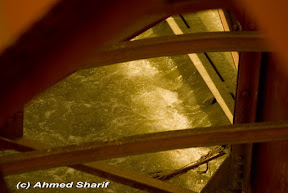 |
| From Bridges of Chittagong, Chittagong, Bangladesh |
The high tide makes the river flow upwards under the bridge......
 |
| From Bridges of Chittagong, Chittagong, Bangladesh |
Fishing in the Karnaphuli current........
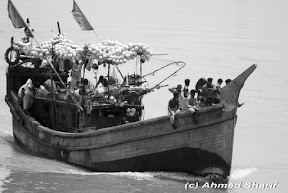 |
| From Bridges of Chittagong, Chittagong, Bangladesh |
Fishing trawler on the Karnaphuli........
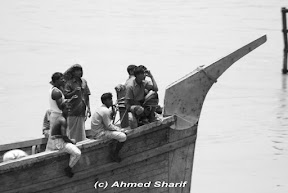 |
| From Bridges of Chittagong, Chittagong, Bangladesh |
Fishermen on the trawler.......
 |
| From Bridges of Chittagong, Chittagong, Bangladesh |
The bubble boat!!!
This river goes straight into the Bay of Bengal. The height of the river is controlled by tide in the sea; so is the current in the river. This current was visible under the bridge. Water was flowing from the sea side. That means it was a time of high tide. There were some fishing going on the north side of the bridge. The fishermen drew their nets and waited. The nets were under tension flowing to the north, following the strong current. Fishermen were waiting on some boats to maintain the nets. There was some traffic in the Karnaphuli. Most of this traffic was the result of fishing trawlers going towards the sea. The trawlers were full of fishing nets that had those white floaters attached. The floaters stood out under the shining sun and gave an interesting look to those boats.
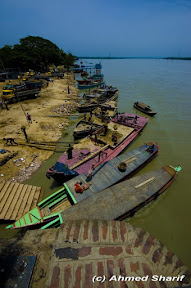 |
| From Bridges of Chittagong, Chittagong, Bangladesh |
The busy northern bank.........
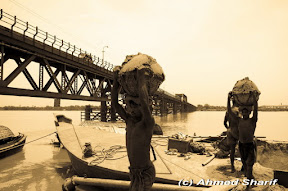 |
| From Bridges of Chittagong, Chittagong, Bangladesh |
Toiling away under the sun.........
 |
| From Bridges of Chittagong, Chittagong, Bangladesh |
Builders of the land........
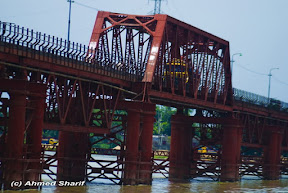 |
| From Bridges of Chittagong, Chittagong, Bangladesh |
The central section of Kalurghat Bridge seen from the northern bank.......
I spent some time photographing the bridge and its surroundings. By around 11:45AM I was again on the northern bank and decided to have a look at the northern end of the bridge. There were many boats parked by the bridge at this end. Quite a busy place. Construction materials, especially sand, was being dumped at this end from boats. Day labourers were toiling hard to unload the boats manually. These are the people that make all the structures possible; the unsung heroes of the land. The place gave me a great look of the whole bridge as well.
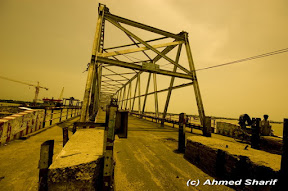 |
| From Bridges of Chittagong, Chittagong, Bangladesh |
The Shah Amanat Bridge..........
 |
| From Bridges of Chittagong, Chittagong, Bangladesh |
The steel structure.........
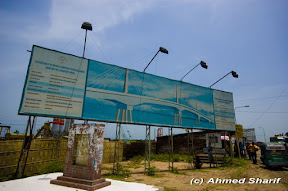 |
| From Bridges of Chittagong, Chittagong, Bangladesh |
The signboard showing the specs of the Third Karnaphuli Bridge.......
By around 12:00 noon I moved out and proceeded towards the second bridge across the Karnaphuli, the Shah Amanat Bridge. It took around half and hour for me to reach there. I was lucky because it was a weekend and there was less traffic on the road. I reached Shah Amanat by around 12:35PM. This bridge is comparatively young, but in a comparatively poor state. It was opened for traffic in 19990. The bridge was damaged by an enormous cyclone on the night of 19th April 1991, when the waves and wind blew a massive floating crane 6.5km and crashed in on the middle spans. The crane drowned under a 400tonne section of the bridge. It took time to repair the bridge and make it operational once more. But the bridge wasn’t built as strongly as the Kalurghat Bridge. So, its current condition isn’t very much delightful. Because of its poor condition, there was a third bridge across the river under construction. This third one is almost beside the Shah Amanat Bridge. Big signboards display the specifications of the under construction bridge.
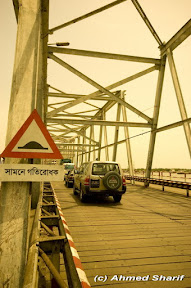 |
| From Bridges of Chittagong, Chittagong, Bangladesh |
Speed breakers galore........
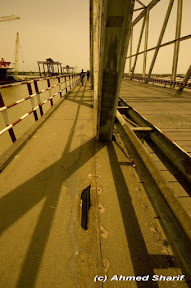 |
| From Bridges of Chittagong, Chittagong, Bangladesh |
The hole in the floor!!
The Shah Amanat Bridge relies on its wooden deck. But the deck developed cracks in many places within 10 years of construction. The bridge never retained its glory and now it shakes with the approach of each vehicle. The bridge was declared unfit for heavy vehicles in May 2000. But smaller vehicles could still cross. Big holes developed in the deck afterwards, which caused frequent accidents. It was then repaired on an emergency basis in 2006-07 at a cost of Taka 55 million. 7,000 wooden planks were imported from South Africa to replace the deck of the bridge. Vehicles still have to maintain a slow progress rate and to ensure that, speed breakers were set up at each and every few yards. Rickshaws and pedestrians cross the bridge by the single lane narrow path on each side of the bridge. This is much better than the Kalurghat Bridge, which doesn’t allow rickshaws to pass and doesn’t care about pedestrians. Rust ate into the structure and some holes formed in the metal floor sections of the bridge floor. I could see the river through those holes!
 |
| From Bridges of Chittagong, Chittagong, Bangladesh |
Construction equipment for the third bridge.........
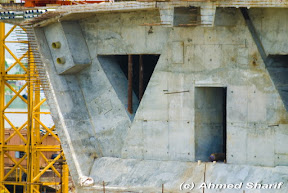 |
| From Bridges of Chittagong, Chittagong, Bangladesh |
The massive pillars..........
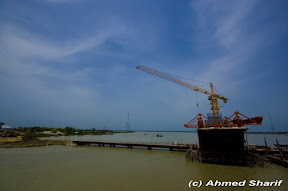 |
| From Bridges of Chittagong, Chittagong, Bangladesh |
And the massive cranes..........
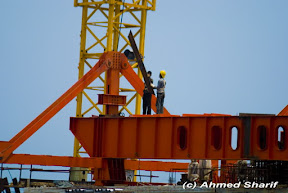 |
| From Bridges of Chittagong, Chittagong, Bangladesh |
Work is going on.........
 |
| From Bridges of Chittagong, Chittagong, Bangladesh |
Construction materials on the northern bank.......
The main attraction of this bridge seemed to be the other bridge! The Third Karnaphuli Bridge’s construction work attracted me more than anything else. This would be a 980m long bridge, which would cost an estimated Tk 5.9 billion. There were big cranes working on the pillars. The northern bank was full of construction materials and fabricated sections. A narrow causeway also made a way for the workers to reach the middle of the river. The bridge had some pillars under construction.
 |
| From Bridges of Chittagong, Chittagong, Bangladesh |
Rickshaw vans and pedestrians crossing........
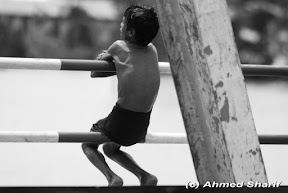 |
| From Bridges of Chittagong, Chittagong, Bangladesh |
A dangerous sport.........
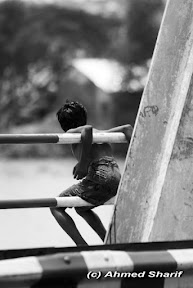 |
| From Bridges of Chittagong, Chittagong, Bangladesh |
Leaning over........
Activity on the Shah Amanat Bridge was also nothing to write home about; just regular traffic. No rail lines here and no need to dodge motor vehicles. Although I had to keep an eye on the rickshaws and rickshaw vans coming my way. Some street children were playing on the other side of the bridge. They were basically hanging by the railings and playing a very very dangerous game!
 |
| From Bridges of Chittagong, Chittagong, Bangladesh |
Under the norther end of the Shah Amanat Bridge.......
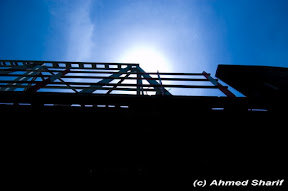 |
| From Bridges of Chittagong, Chittagong, Bangladesh |
It was a heated sun........
 |
| From Bridges of Chittagong, Chittagong, Bangladesh |
The Shah Amanat Bridge........
I went to the northern end of the bridge once more and sought to take some photographs from that angle. Some children were playing under the bridge’s dry areas, whereas some adults were relaxing under the cool shadow of the bridge.
It was around 12:00PM when I decided to break off. The tour was a good documentation of a place and time which is going through a lot of transition. This record would help to compare the landscape some time later. Chittagong is my favourite city. I would surely have my chances to visit here once more, unless God sees it otherwise.


This blog is amazing!!!I love to drive by a bridge, actually there are bridge beautiful for their structure or their size. simply love it. I´ll approach
ReplyDeletecosta rica investment opportunities in this country there are land that need big bridges.